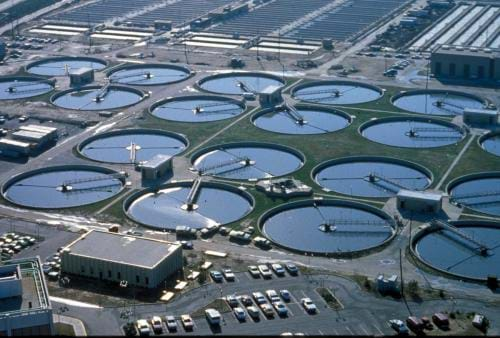
Summary
Fresh water is a limited and valuable natural resource, and engineers play a key role in designing systems that provide fresh water to everyone. In this activity, students learn about water conservation and how water is cycled naturally on Earth and through the wastewater management system. Using parts of the engineering design process, students design a system that allows blackwater to be recycled at the place of use (for example, near a toilet or home as opposed to at a wastewater treatment plant. Students then explain how this recycled water could then be reused as effluent toilet water.Engineering Connection
By applying principles of engineering design, engineers look for ways to solve societal problems, improve lives or improve products. Engineers look at a natural or human-made phenomena and see if there is room to improve upon or create systems that make lives better. There is always a tangible objective and outcome that engineers attempt to reach. In this activity, students design a model that allows for recycling of blackwater.
Learning Objectives
After this activity, students should be able to:
- Sketch and design a homemade blackwater recycling device that allows recycled water to be reused as toilet water.
- Build a model that represents a homemade blackwater cleaning device.
- Explain how their model works to their fellow peers through the various processes of cleaning at the macro scale and possibly nanoscale.
Educational Standards
Each TeachEngineering lesson or activity is correlated to one or more K-12 science,
technology, engineering or math (STEM) educational standards.
All 100,000+ K-12 STEM standards covered in TeachEngineering are collected, maintained and packaged by the Achievement Standards Network (ASN),
a project of D2L (www.achievementstandards.org).
In the ASN, standards are hierarchically structured: first by source; e.g., by state; within source by type; e.g., science or mathematics;
within type by subtype, then by grade, etc.
Each TeachEngineering lesson or activity is correlated to one or more K-12 science, technology, engineering or math (STEM) educational standards.
All 100,000+ K-12 STEM standards covered in TeachEngineering are collected, maintained and packaged by the Achievement Standards Network (ASN), a project of D2L (www.achievementstandards.org).
In the ASN, standards are hierarchically structured: first by source; e.g., by state; within source by type; e.g., science or mathematics; within type by subtype, then by grade, etc.
NGSS: Next Generation Science Standards - Science
-
DCI.ETS1.A.9-12.3.
Humanity faces major global challenges today, such as the need for supplies of clean water and food or for energy sources that minimize pollution, which can be addressed through engineering. These global challenges also may have manifestations in local communities.
(Grades 9 - 12)
More Details
Do you agree with this alignment?
| NGSS Performance Expectation | ||
|---|---|---|
|
HS-ESS3-4. Evaluate or refine a technological solution that reduces impacts of human activities on natural systems. (Grades 9 - 12) Do you agree with this alignment? |
||
| Click to view other curriculum aligned to this Performance Expectation | ||
| This activity focuses on the following Three Dimensional Learning aspects of NGSS: | ||
| Science & Engineering Practices | Disciplinary Core Ideas | Crosscutting Concepts |
| Design or refine a solution to a complex real-world problem, based on scientific knowledge, student-generated sources of evidence, prioritized criteria, and tradeoff considerations. Alignment agreement: | Scientists and engineers can make major contributions by developing technologies that produce less pollution and waste and that preclude ecosystem degradation. Alignment agreement: When evaluating solutions it is important to take into account a range of constraints including cost, safety, reliability and aesthetics and to consider social, cultural and environmental impacts.Alignment agreement: | Feedback (negative or positive) can stabilize or destabilize a system. Alignment agreement: Engineers continuously modify these technological systems by applying scientific knowledge and engineering design practices to increase benefits while decreasing costs and risks.Alignment agreement: |
| NGSS Performance Expectation | ||
|---|---|---|
|
HS-ETS1-2. Design a solution to a complex real-world problem by breaking it down into smaller, more manageable problems that can be solved through engineering. (Grades 9 - 12) Do you agree with this alignment? |
||
| Click to view other curriculum aligned to this Performance Expectation | ||
| This activity focuses on the following Three Dimensional Learning aspects of NGSS: | ||
| Science & Engineering Practices | Disciplinary Core Ideas | Crosscutting Concepts |
| Design a solution to a complex real-world problem, based on scientific knowledge, student-generated sources of evidence, prioritized criteria, and tradeoff considerations. Alignment agreement: | Criteria may need to be broken down into simpler ones that can be approached systematically, and decisions about the priority of certain criteria over others (trade-offs) may be needed. Alignment agreement: | |
Materials List
For the entire class to share:
- laptop or tablet with projector and internet access
Each group needs:
- laptop or tablet with projector and internet access (optional)
- plastic tubing: 1-foot - ½ inch = 1.40 / foot
- elbow L fitting adapter: two - ½ in male elbow barbed fitting
- PVC pipes: four - ½ in x 6 in PVC pipes = 2.87/ft
- cardboard pieces: eight - 5 in x 7 in cardboard pieces = 0.12/count
- Plexiglass: two - 5 in x 7 in = 0.80/each
- pair of scissors
- hot glue gun and glue sticks
- masking tape
Worksheets and Attachments
Visit [www.teachengineering.org/activities/view/rice-2781-recycle-water-cleaning-device-activity] to print or download.Pre-Req Knowledge
Students should have a basic understanding of the water cycle.
Introduction/Motivation
Water conservation is not only vital to our very existence as a species, but also important to every living ecosystem. In addition, all businesses, especially manufacturing businesses, cannot conduct their business without water. Water usage at home is equally important to get us through the day, such as use in showers, restrooms, or household appliances. Water is essential to every aspect of our lives.
However, water is a resource that is ultimately finite. While salt water is abundant, fresh water makes up only 3% of the total amount of water on Earth. To desalinize ocean water takes a tremendous amount of energy and is incredibly expensive. Therefore, we must change our habits around water.
What would you do to help conserve water? (Potential answers: Take shorter showers/baths; don’t water lawns; etc.) What are the ways we could influence change and help people change their behavior when it comes to water usage? (Potential answers: present empirical data and information to the public; come up with viable plans and options for the public to implement change; change government laws and policies.)
How would we change policy when it comes to water usage? This requires convincing politicians to make policy changes. Possible policy changes may include requiring businesses and neighborhoods to use desert landscaping, limiting the construction of golf courses, raising the water usage for pool owners to a premium, require farming and home irrigation only at night, and fining people and businesses for water usage violations.
Home habits can also be changed through public education perhaps requiring that water conservation be taught in our public schools at all levels. Or perhaps school districts should require water conservation projects to be a requirement for senior graduation.
Today we are going to explore how to reduce the amount of water we waste when we flush the toilet. First, let’s talk about what happens to the water that we flush. When water leaves the house, via gravity, it leaves the home through a series of underground channels and eventually makes its way to the nearest wastewater treatment plant. A big portion of the water does not make it to the plant, but the water that does first goes to the bar screen to mechanically remove very large objects using a moving step ladder. After the bar screen, the water goes through the grit chamber, which removes particles such as sand and rock using the vortex method. The next step involves multiple primary clarifiers, which use the science of settling velocity. In this step, the flow rate must be less than the settling velocity of the particles. At that point, the water is considered effluent because it is free of solids larger than 10 µM (micrometer) and all remaining particles are organic matter. At this point, the water is passed through the aeration basin to activate the sludge, which increases aerobic digestion from the bacteria that eats away at the organic matter. Water will then go to the secondary clarifiers multiple times in which returned activated sludge settles and removes more solids and larger biological particles. The final step involves filtration that removes at least 85% of the solids from the effluent water, then is disinfected by UV radiation light, chlorine, or ozone.
If we can recycle it closer to the home, we might be able to mitigate the amount of water lost during the treatment process. Globally 80% of wastewater goes untreated and makes its way back to the ecosystem. In this activity, we will explore ways to recycle water closer to home by designing a way to recycle home toilet water!
Procedure
Background
Water conservation is not only vital to our very existence as a species, but also important to every living ecosystem. In addition, all businesses, especially manufacturing businesses, cannot conduct their business without water. Building infrastructure requires water – building foundations use of cement for example. Water usage at home is equally important to get us through the day, such as shower and restroom usage, washing dishes, washing clothes, etc. Water is essential to every aspect of our lives.
When water leaves the house, usually via gravity, it moves through a series of underground channels and eventually makes its way to the nearest plant. The water first goes to a bar screen to mechanically remove very large objects using a moving step ladder. After the bar screen, the water goes through the grit chamber, which removes particles such as sand and rock using a type of vortex that spins out particles. The next step involves multiple primary clarifiers. In this step, the flow rate must be less than the settling velocity of the particles. At that point, the water is considered effluent because it is free of solids larger than 10 µM (micrometer) and all remaining particles are organic matter. At this point, the water is passed through the aeration basin to activate the sludge, which increases aerobic digestion from the bacteria that eats away at the organic matter. Water will then go to the secondary clarifiers multiple times in which returned activated sludge settles and removes more solids and larger biological particles. The final step involves filtration that removes at least 85% of the solids from the effluent water, then is disinfected by UV radiation light, chlorine, or ozone.
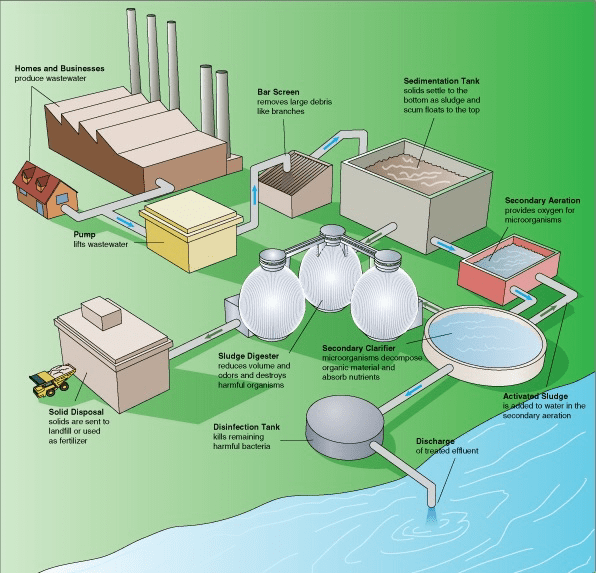
Water is considered effluent when it is free of solids larger than 10 µM and all remaining particles are organic matter. One micrometer (1 µM) is equal to 10-6 meter or 1-meter equals 1 million micrometers.
As we flush the toilet, a large percentage of the flushed water never makes it to the WWTP. Therefore, if we can recycle it closer to the home, the less likely the water will be lost. In addition, globally 80% of wastewater goes untreated and makes its way back to the ecosystem, according to unwater.com.
In nature, water is filtered through the different types of permeable soils until it hits a nonpermeable rock and collects as underground water or aquifers. The nitrogen cycle is also nature’s way of nitrifying the nitrogen found in natural waste (urine and solid waste), which mostly comes from protein molecules. During the nitrification, ammonia (NH4+) and ammonia (NH3) is converted to nitrite (NO2-), then nitrate (NO3-), and finally it goes through denitrification where nitrate becomes nitrogen gas (N2). Where is the evidence for the nitrogen gas found – in the Earth’s atmosphere. Around 70% of the air we breathe is nitrogen gas. A treatment plant simply and artificially increases the rate of nitrification by using bacteria in sludge to break down nitrogen compounds during the aeration process. During the aeration step, oxygen is required to activate and carry out the aerobic digestion. In the following figure, “E” represents energy.
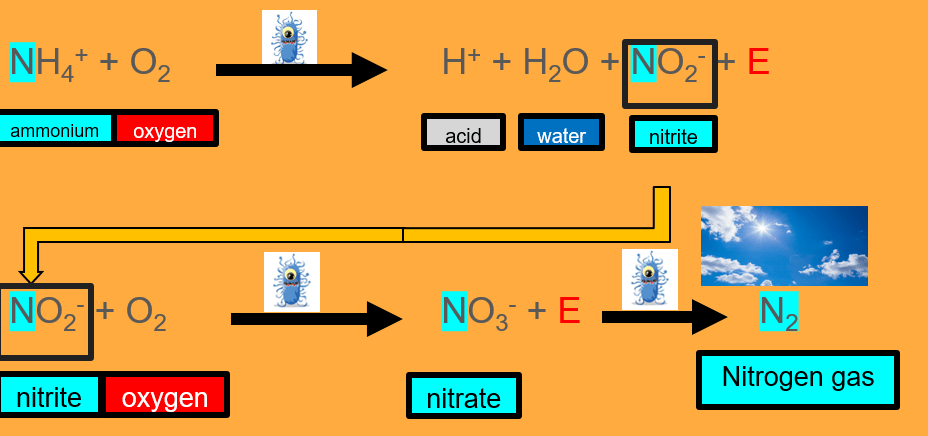
Before Activity:
- Gather all supplies and make sure each group has the proper materials at their station.
With the Students:
Ask and Research
- Display the Recycle Home Toilet Water Presentation to the students.
- Read through slides 2 and 3.
- Show the video: How do Wastewater Treatment Plants Work? https://youtu.be/FvPakzqM3h8
- Show the video: Nitrogen Removal Basics https://youtu.be/BosHU4ARR9w
- After watching the video say: During the nitrification, ammonia (NH4+) and ammonia (NH3) is converted to nitrite (NO2-), then nitrate (NO3-), and finally it goes through denitrification where nitrate becomes nitrogen gas (N2). Where is the evidence for the nitrogen gas found?
NH4+/ NH3 --> NO2- --> NO3- --> N2
- Have students answer the Pre-Assessment section on the Assessment Worksheet
- Go through the slides 6 and 7 with the class.
- Have students get into groups of three.
- Have students work in their groups to place the processes for treating wastewater in the correct order on their Assessment Worksheet.
- Review slide 9.
Brainstorm and Sketch
- Show slide 10.
- Have each group sketch and design their device setup, making sure to clearly write their device’s water- cleaning process. It should cover all phases of treating blackwater.
- Present slide 11 of the Recycle Home Toilet Water Presentation.
- Have each group create a data table that will show relevant data that would be necessary to demonstrate their device efficiency.
Build
- Have each group construct their home wastewater treatment model using the materials at their station. Note: Students can have more materials by asking the teacher for more supplies. Students are also not required to use all their table supplies.
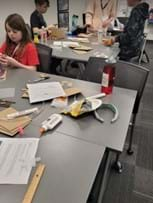
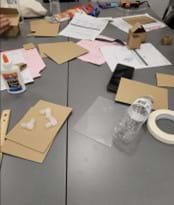
Test
- Have groups exchange their sketch papers which contains the rubric for their devices with other groups.
- Have students rate the other group’s design and model using the rubric scale. This will be constructive criticism.
- Have each group discuss whether this group explained why their design shows the best way to recycle wastewater? Why or why not?
Iterate and Reflect
- As a class, discuss what was learned. Specifically discuss what worked and what problems were found, what are some areas room for improvement, and important takeaways.
- If time, give students time to improve their models.
Vocabulary/Definitions
aeration basin: A holding and/or treatment pond provided with artificial aeration to promote the biochemical oxidation of wastewaters.
biochemical oxygen demand: The amount of dissolved oxygen that must be present in water for microorganisms to decompose the organic matter in the water, used as a measure of the degree of pollution.
blackwater: Wastewater from toilets.
clarifier: A sedimentation tank, also called settling tank, and is a component of a modern system of water supply or wastewater treatment. A sedimentation tank allows suspended particles to settle out of water or wastewater as it flows slowly through the tank, thereby providing some degree of purification.
disinfection: One of 3 different methods of cleansing wastewater: Chlorine – naturally consists of two chlorine atoms covalently bonded; Ozone – molecule with 3 oxygen atoms naturally found in the upper levels of the atmosphere; UV – ultraviolet radiation is high energy light on the EM spectrum that is just past visible light on the spectrum.
dissolved oxygen: A measure of how much oxygen is dissolved in the water that is available to living aquatic organisms.
effluent: Liquid waste or sewage discharge that has been treated in septic tank or sewage treatment plant and is normally discharged into a river or the sea.
graywater: Wastewater from showers, baths, or sinks.
grit chamber: Tanks that are designed to slow down the flow so that solids such as sand, coffee grounds, and eggshells will settle out of the water.
micrometer: One-millionth of a meter (10^-6). It is also referred to as a micron or 1 µm.
nanoscale: One-billionth of a meter (10^-9). Therefore, the nanoscale are objects with a measurement between 1nm to 100nm.
nitrogen cycle: The series of processes by which nitrogen and its compounds are interconverted in the environment and in living organisms, including nitrogen fixation and decomposition.
returned activated sludge : The settled returned activated sludge (biomass) that is collected in a secondary clarifier and returned to the secondary treatment process to mix with incoming wastewater. This returns a concentrated population of microorganisms back into the aeration basin.
waste activated sludge: A process with high concentration of microorganisms, basically bacteria, protozoa and fungi, which are present as loose clumped mass of fine particles that are kept in suspension by stirring, with the aim of removing organic matter from wastewater.
water cycle: The cycle of processes by which water circulates between the earth's oceans, atmosphere, and land, involving precipitation as rain and snow, drainage in streams and rivers, and return to the atmosphere by evaporation and transpiration.
Assessment
Pre-Activity Assessment
Watch the video: How do Wastewater Treatment Plants Work? https://youtu.be/FvPakzqM3h8 (10:02)
Students fill out the Pre-Assessment section on the Assessment Worksheet.
Watch the video: Nitrogen Removal Basics: https://youtu.be/BosHU4ARR9w (11:54)
Students fill out the Pre-Assessment section on the Assessment Worksheet.
Activity Embedded (Formative) Assessment
Students answer the Formative Assessment section of the Assessment Worksheet.
Sketching: Students plan and sketch their home wastewater treatment device.
Engineering: Students build and create their home wastewater treatment device using materials provided.
Post-Activity (Summative) Assessment
Students demonstrate and explain their home wastewater treatment device. Class discussion of results.
Investigating Questions
Can you design a home device that would be able to recycle blackwater to be reused as toilet water before it leaves your home?
Safety Issues
- Be careful and don’t burn yourself with the hot glue gun.
- Be careful with the scissors while cutting cardboard.
Activity Extensions
Consider creating a model by combining your model with another group’s model.
Activity Scaling
- Lower Grades: Many of the pieces of each water-cleaning processes will have to be prebuilt.
- Upper Grades: The group’s sketch will have to show how recycled water will be tested.
Subscribe
Get the inside scoop on all things TeachEngineering such as new site features, curriculum updates, video releases, and more by signing up for our newsletter!More Curriculum Like This

Students learn about the human water cycle, or how humans impact the water cycle by settling down in civilizations. Specifically, they learn how people obtain, use and dispose of water.

Students learn how plastics in the human trash stream end up as microplastic particles entering the food chains via polluted water, harming animals and people. They think of ways to reuse or replace the common plastic items they discard daily. They learn how microplastics persist in the environment ...
References
Tuser, Christina. Water and Waste Digest. October 27, 2021. https://www.wwdmag.com
The Wastewater Treatment Process. https://www.coleparmer.com/tech-article/eight-stages-of-wastewater-treatment-process
Water Science School. USGS Science for a Changing World. June 15, 2018. https://www.usgs.gov/special-topics/water
Copyright
© 2023 by Regents of the University of Colorado; original © 2023 Rice UniversityContributors
Gerardo LopezSupporting Program
Research Experience for Teachers NEWT in coordination with Rice University, Arizona State University, and the National Science FoundationAcknowledgements
This curriculum was based upon work supported by the National Science Foundation under Rice University Engineering Research Center for Nanotechnology Enabled Water Treatment Systems (NEWT) RET grant no.1449500. Any opinions, findings, and conclusions or recommendations expressed in this material are those of the authors and do not necessarily reflect the views of the National Science Foundation.
Last modified: August 30, 2023




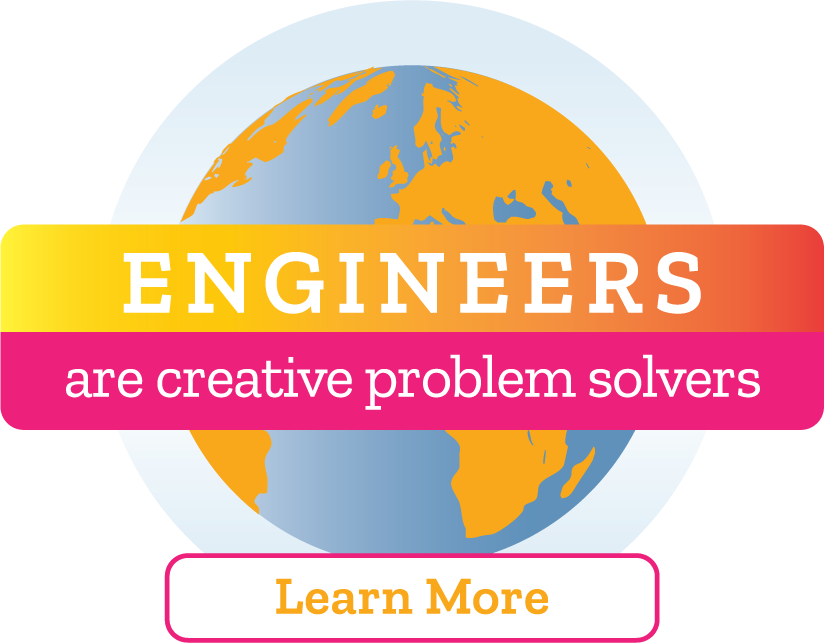

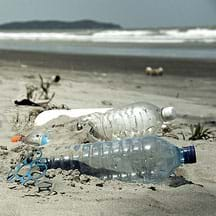
User Comments & Tips